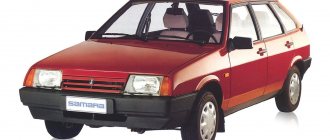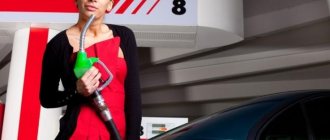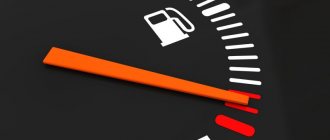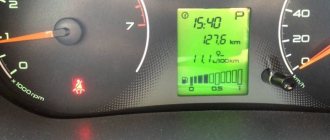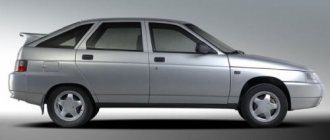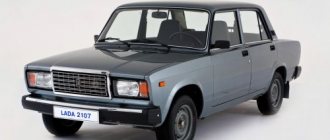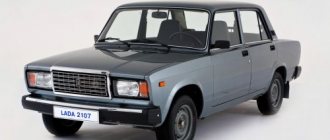The famous ninety-ninth model is still very popular among domestic car enthusiasts. This is a practical sedan that replaced the no less popular “nine”, which was produced in a hatchback body. Among the advantages of the car, car enthusiasts note:
- body capacity;
- reliability of all units;
- maintainability;
- cheap spare parts;
- optimization for domestic roads and climate.
One of the reasons for the popularity of the car is economical fuel consumption for all versions of the VAZ 21099. The car was produced from 1990 to 2004 at the main facilities of the plant, after that for another 8 years at one of the Ukrainian plants.
How to calculate gasoline consumption per 100 km?
Any driver is interested in the question of how many liters of gasoline his car “eats.” Reading the characteristics of a particular model, we see fuel consumption, which shows how much gasoline the engine needs to travel 100 kilometers in the urban or extra-urban cycle, as well as the arithmetic average of these values - fuel consumption in the combined cycle.
Nominal and actual fuel consumption may differ, usually not very significantly.
- technical condition of the car - while the engine is being run-in, it consumes more fuel, then the consumption level decreases to the norm specified in the instructions, and as it wears out it increases again;
- riding style is an individual matter for each individual;
- weather conditions - in winter the engine consumes more fuel, in summer - less;
- use of additional energy consumers;
- aerodynamics - when the windows are open, the aerodynamic properties decrease, air resistance increases, and accordingly more gasoline is needed;
- aerodynamic properties can be improved by installing spoilers and streamlined elements.
You are unlikely to be able to calculate the exact standard fuel consumption values, down to the milliliter, but you can calculate the approximate consumption for different driving conditions very simply, you don’t need to be a great mathematician for this, you just need to remember the mathematics course for the third or fourth grade and know that these are the proportions.
The calculation formula used by flow calculators is very simple:
Divide the displacement by the mileage and multiply by one hundred - l/km * 100.
How to reduce fuel consumption on a VAZ 2109 carburetor
If you have high fuel (gasoline) consumption and you don’t know what the reason is, then for a VAZ 2109 car with a new carburetor or an old one
, this article may be useful, it is also relevant for other cars with similar characteristics.
It should be noted that the main reason for the increase in fuel consumption is a violation of the standard regulation of the power system. For this reason, many vehicle owners are interested in how to reduce fuel consumption on a VAZ 2109 carburetor that is configured incorrectly.
In order to find the cause of the malfunction, first of all, it is recommended to look under the air filter cover.
Common reasons for increased fuel consumption:
• Even a slight opening of the throttle can cause an increase in fuel consumption. A similar defect is quite common on Solex carburetors. • For Ozone carburetors, a common malfunction is poor operation of the shut-off valve in the float chamber. Thus, an engine idling will have wet diffusers due to fuel leakage
It is also recommended to pay attention to filters. A dirty filter can cause the mixture to become too rich.
• Another reason for high fuel consumption is a loose solenoid valve on DAAZ carburetors. Such a problem can lead to wear of the conical part of the jet, as well as the seat directly in the carburetor body. • Incorrectly set ignition timing. • Oxidation of the socket in the distributor cover and oxidation of the contacts of high-voltage wires. • Spark plugs working intermittently or not working at all. • Even poorly adjusted toe-in, defects in the brake system (seized pads) and insufficiently inflated tires can lead to increased fuel consumption.
The first way to reduce fuel consumption:
• A working engine should be warmed up to 80 degrees Celsius. • Looking at the position of the tachometer needle, set the speed approximately 15% higher than recommended in the car instructions. Adjustment is carried out using a quality screw. • Next, also use the quality screw, increase the speed even higher. At the same time, use the screw to reduce the speed to the starting position. • The adjustment procedure should be carried out until turning the screws (quality, quantity) does not produce an increase in speed. • Now, the quality screw should be tightened until the speed drops to the level specified in the instructions.
As a result, a level is reached at which the mixture will not become excessively lean, and the CO indicator will correspond to the norm. Next, you should check the operation of the engine. The mixture is too lean if the engine starts to stall when closing the throttle quickly or braking hard. In this situation, you need to slightly unscrew the quality screw.
The second way to reduce fuel consumption:
• For a serviceable engine, warm up the engine to 80 degrees Celsius. • Unscrew the quantity screw and set the crankshaft rotation speed to a level that should theoretically correspond to the parameters specified in the instructions supplied with the vehicle. • Next, also turn on the quality screw and increase the rotation speed a little more. • Slowly tighten the quality screw until the engine begins to “shake”, so to speak. In some cases, at the same time the speed screw should be added, especially if there is a strong drop in speed. • Then, unscrew the quality screw by approximately one-third of a turn so that the motor begins to operate stably. • Change the crankshaft rotation speed with the screw to the level specified in the instructions. At this stage, the adjustment can be considered complete.
Troubleshooting
Timely maintenance will extend the life of the car
If your car's fuel system has a carburetor, the algorithm is as follows:
- You should start by inspecting the fuel lines. It is quite possible that fuel is leaking through poorly tightened clamps or microcracks in the hoses and pipes.
- If the fuel lines are intact, then you should inspect the fuel tank and check the tightness of the filler cap. If the cap is not closed tightly in warm weather, gasoline may evaporate from the tank.
- Next, you should inspect the carburetor. It is possible that gasoline is evaporating or leaking through cracks in the lid or body of the device.
- The next step is to remove the VAZ 21099 air filter cover and inspect the filter element. If it is dirty, it needs to be replaced. The fact is that when the air filter is dirty, the amount of air in the combustible mixture decreases and, accordingly, the amount of fuel increases, which causes consumption to increase. The same thing happens when the air jets become dirty. You can recognize the over-enrichment of the combustible mixture by the black or dark gray color of the exhaust gases.
- Next, you need to inspect the fuel filter housing. If it is cracked, replace the fuel filter. Most fine fuel filters are made of transparent or translucent plastic. Thanks to this, you can see the dirt accumulated inside. Replacing the fuel filter should be done simultaneously with replacing the engine oil, oil and air filters. Otherwise, dirt will enter the carburetor and contaminate the jets and diffusers.
- Check the fuel pump for cracks and leaks.
- If a thorough inspection of the pump does not reveal any leaks, you will have to clean and adjust the carburetor.
Before setting up the carburetor, it is imperative to adjust the valves and set the correct ignition timing.
If you have a VAZ 21099 injector, you must perform the same steps, with the exception of inspecting the fuel pump. The difference is that instead of the carburetor, you will have to clean and adjust the injector. This procedure is complex, so it is better to carry it out at a car service center.
If you've followed the suggested steps and your car is still consuming too much fuel, take a closer look at how you measure your fuel consumption.
VAZ 21099-20 1.5 MT 78hp
Fuel consumption rate per 100 km
Not the most popular version, despite the engine technical data typical for Russia. As in other modifications, the unit operates with a 5-speed manual transmission on gasoline. He freely accepts AI92, although his passport requires 95. Consumption is even more modest than that of a similar unit with 70 horsepower: city – 8.8 liters, highway – 5.4 liters. Maximum acceleration is up to 156 km per hour.
Owners about fuel consumption
- Mikhail, Belgorod. For five years I had a 1.5-liter 74-horsepower 99 (2003 onwards). I liked going to the dacha. It takes a little off-road without any problems, and the appetite hardly grows (consistently 9.5 liters). For example, Niva on the same road consumes almost 13 liters per hundred.
- Roman, Izhevsk. I tried chipping my 1999 1.5 MT. Almost nothing has changed, although many talked about saving fuel. The ninety-ninth ate 9.5 liters in the city, and still eats it. Perhaps it’s half a liter less on the highway (6 instead of 6.8), but my wallet laughs at such savings.
- Andrey, Kursk. I learned to drive a 1.5 manual 2001. It’s hard to imagine a better car for a beginner. I fill up with 10 liters and don’t think about fuel for 3-4 days. At the same time, I drive about 60 km/h in third gear. Very economical and without unnecessary hassles.
- Stepan, Rybinsk. Of course, traveling long distances in the 99 is difficult due to the lack of comfort. I had a regular one and a half liter engine (74 horses). The car is old (2000), but it made it to the Black Sea. I needed two and a half tanks (about 100 liters) to get to the resort. At the same time, the consumption according to the meter rarely exceeded 7 liters.
- Alexander, Tambov. 21099 2002 1.5 74 hp I had a serious problem with fuel once. I knew that it was better not to fill up at this gas station, but for some reason I stopped by. As a result, there is carbon deposits on the spark plugs and consumption jumps to 12 liters per hundred. And so it lasted a little less than 10 liters.
Fuel consumption, accessibility and low cost of repairs are the main advantages of the VAZ 21099. Although the time of this sedan has long passed, because today the car enthusiast is no longer satisfied with simplicity and efficiency. Manufacturability and ecology are at a premium. By these parameters, the 99th remained in the last century.
https://rasxodtopliva.ru/47-vaz-21099.htmlhttps://twokarburators.ru/bolshoy-rashod-topiva-injektornym-dvigatelem-prichiny/https://xtoplivo.ru/vaz/rashod-topliva-vaz- 21099https://driverstalk.ru/rashod-topliva-vaz-21099.htmlhttps://avtobak.net/vaz-21099-otzyvy-o-rasxode-topliva.html
Consumption of VAZ 21099 with carburetor
Initially, the car was equipped with several modifications of gasoline engines of various designs and volumes. The most affordable was the 1.3 engine with 64 horsepower. It, like other versions of the car, was equipped with a five-speed manual transmission with front-wheel drive. The car accelerated to hundreds in 14.5 seconds with a top speed of 140 km/h. With a carburetor fuel supply system, the fuel consumption of this engine was:
- city 9.1 l;
- average 7.7 l;
- on the highway 5.7 liters.
A rotary version of the engine of the same volume with 135 horsepower was offered, but it was supplied to special services and for export. The installation of this power unit improved the dynamics, but at the same time fuel consumption increased:
- in city mode 12.5 l:
- in a mixed cycle 10 l;
- on a free road 7 l.
The most popular was the 1.5 engine with 70 horsepower; it was distinguished by its reliability, accelerating the car to 150 km/h, and to the first hundred in 14 seconds. It is fueled with AI 92 or AI 95 with fuel consumption similar to the less powerful version:
- in traffic 9.1 l;
- on average 7.7 l;
- on the highway 5.5 l.
Why do the calculations?
Periodic fuel consumption calculations are useful for several reasons:
- Budget planning. You will know how much of your salary should be set aside for gasoline.
- Organization of long trips. If you have a long journey ahead, you can calculate in advance whether there is enough fuel for it or whether it is better to refuel before the road, or even take the tank with you.
- Diagnostics. If fuel consumption differs significantly from the previous time, this may indicate a problem with the car (if, of course, travel conditions remained approximately the same).
- Testing. Once you receive the machine for a preliminary test, you will determine how expensive it will be to maintain. The obtained value may differ from that declared by the manufacturer due to the climate and topography of your region.
Consumption of VAZ 21099 with an injector
Injectors began to be installed on the VAZ 21099 in 2000. Direct fuel injection made it possible to increase the power of power units, while reducing their fuel consumption. The most popular injection modification of the car comes with a 1.5 engine. The designers increased the power to 78 hp, acceleration to hundreds is 13.5 seconds with a maximum speed of 155 kilometers per hour with fuel consumption:
- in traffic 8.8 l;
- on average 7.4 l;
- on a country road 5.4 liters.
The most powerful version with a volume of 1.6 produces 81 hp, reaches a speed of 165 km/h, and the first hundred in 13 seconds. At the same time, the car’s appetite remains quite modest:
- on busy streets 9.1 l;
- mixed mode 7.7 l;
- track 5.7 l.
Real consumption according to reviews
- Svyatoslav, Chelyabinsk. I took the “99” model in 2012 as a workhorse. I chose the option with the 1.5 engine. A very reliable option with an injector, I’m very happy with the car, I go both for work and for fishing, the ground clearance allows me to go outdoors without problems. The consumption of AI 95 in a circle is about 8 liters.
- Sergey, Barnaul. VAZ 21099 2003 with an injector. The car was in excellent condition, nothing had to be done. Over time, I treated the body and repaired the chassis several times - but this is a necessary evil on our roads. The 1.5 engine is very good - it pulls consistently, I only change consumables, I didn’t have to clean the injector. Consumption in the city is no more than 9 liters, and on the highway the car takes 6-7 liters.
- Dmitry, Ulyanovsk. In 2004, I took the most sophisticated version of the VAZ 21099 Lux with a 1.6 engine. The car is powerful, reliable, roomy, and passable. Repairs cost pennies, and they have to be done infrequently; I didn’t do anything to the engine, gearbox, or injector. The average consumption is 7-9 liters, which corresponds to the passport data.
What does engine volume mean in a car - 1.2 l, 1.4 l, 1.6 l, etc.?
The displacement of an engine largely reflects its power and other operating parameters.
And, first, we must decide that - 1 liter = 1000 cc (cubic centimeters or cm3).
So, a car with a 1.2 liter engine will have the following volume:
1.2 × 1000 = 1200 cc,
Similarly, let’s take a car with an engine capacity of 1.4 liters, respectively a volume of 1400 cc and so on.
The engine displacement is equal to the sum of the displacements of all the engine cylinders, so if a 1.2 liter car has a 4-cylinder engine, this means that the volume of each cylinder is 1200 ÷ 4 = 300 cc. cm.
The volume of the cylinder – V, is determined by the formula:
where D2 is the squared diameter of the cylinder and h is the stroke length of the cylinder.
So when you calculate the volume of each cylinder of a 1200cc 4 cylinder car. cm, using the above formula, measuring the diameter and stroke, you end up with 300 cc. cm or a little more, but very close to 300 cm3, since the number π is not an absolute number.
Now, about the technical part
:
What does it matter?
In general, an engine's performance (power, torque, acceleration, etc.) is entirely dependent on how much fuel it can burn as the piston reciprocates inside the cylinder; that is, when it moves from the highest point of the cylinder, called top dead center, to the lowest point of the cylinder, called bottom dead center.
But, there is one catch!
You can't add an infinite amount of fuel, because you need air to fully burn that fuel, and the unburned fuel doesn't go into the exhaust pipe and detonate there.
This means that to get more performance, you need to burn more fuel, and in order to burn more fuel, you need to suck a lot of air into that cylinder.
The simplest way to do this is to have a larger capacity cylinder that will hold a larger volume of air, and thus be able to burn more fuel, providing better performance.
However, keep in mind that a larger engine also means it will be less fuel efficient.
Because it will have to burn a certain amount of fuel to keep running and will consume more fuel even at low speeds and engine speeds when you don't really need those performance.
And although there are other ways to increase performance, increasing engine size is the simplest, and most primitive way to do it.
However, existing more modern technologies such as turbocharging, or increasing the compression ratio using direct injection, are much more effective methods as they do not have a significant effect on increasing fuel consumption.
Thus, today, the formula - “a more powerful engine is a better engine”, in fact, no longer works.
Because, thanks to improved technology, small engines have become more powerful and at the same time economical!
Source
Setting the ignition timing
When the ignition timing is correctly set, all indicators of engine performance (reactivity, power, idling, energy consumption) are within normal limits. To carry out the work, you must have a strobe and a tachometer, an open-end or socket wrench of 10. In general terms, the setup is done as follows:
- The engine warms up to operating temperature. Low idle speeds are set by ear or on the tachometer (less than 800 rpm), after which the engine is turned off.
- On the gearbox housing, look for a hatch with a visible part of the flywheel and a scale. Most often it is closed with a rubber stopper that needs to be removed.
- By turning the flywheel with a screwdriver, the long alignment mark is located. The lead angle is 0 degrees if the mark is opposite the triangular notch on the scale. In this case, the pistons of cylinders 1 and 4 are at top dead center.
- The strobe light is connected and the engine is turned on to idle. A flashing strobe beam is directed into a hatch with a scale. In the beam, the highlighted mark should be opposite the desired scale division, where each division corresponds to one degree of ignition timing.
The advance angle is adjusted by rotating the distributor (ignition distributor housing). Clockwise - the advance angle increases (early ignition), counterclockwise - decreases (late ignition). When the desired angle is set, the engine is turned off, the strobe light is turned off, and the distributor is secured.
Official data (l/100 km)
| Engine | Consumption (city) | Consumption (highway) | Flow (mixed) |
| 1.1 MT 54 hp (Mechanics) | 8.2 | 5.4 | 7.1 |
| 1.3 MT 64 hp (Mechanics) | 8.6 | 5.4 | 6.2 |
| 1.5 MT 68 hp (Mechanics) | 8.6 | 5.7 | 6.4 |
| 1.5 MT 78 hp (Mechanics) | 8.0 | 5.4 | 6.1 |
| 1.5 MT 72 hp (Mechanics) | 8.0 | 5.5 | 7.7 |
One of three gasoline engines could be installed on the car. The smallest - 1.1 liters, had a power of 54 horsepower. The fuel supply here was carried out by a carburetor. Fuel consumption per 100 km was 8 liters in the city and 5.3 liters on the highway. A slightly larger 1.3 liter engine. It is already capable of developing 64 horsepower.
Fuel is also supplied via a carburetor. There is also a 1.5 liter engine, which, depending on the fuel supply system, develops different power. If a carburetor is installed, the engine can produce a maximum of 72 horsepower. If the injector is 78 hp. But then the consumption has increased - it is 9 and 7.5 liters, respectively.
Adjusting the power system
If your car has a Solex carburetor, how to reduce fuel consumption is not an idle question.
One of the main reasons for increased gasoline costs in carburetor engines is an unregulated power system. You can check this yourself by removing the air filter cover and taking a closer look at the position of the air damper.
If the damper is opened even just a little, then it already creates a kind of screen above the diffuser. This increases the flow of the mixture due to increased vacuum. Many cars equipped with Solex have problems with overspending precisely for this reason (VAZ - 2108, VAZ - 2109, VAZ - 21213).
Also, when carrying out this procedure, you should pay attention to the condition of the air filter itself. A clogged, dirty filter leads to over-enrichment of the mixture with gasoline. It is advisable to replace such a filter.
Often, carburetor masters, in pursuit of improving dynamics, bend the nozzle tube of the accelerator pump of the secondary chamber so that gasoline flows from both tubes only into the first chamber. This leads to large excess consumption of fuel and “nervous” behavior of the car.
How to reduce fuel consumption
Despite the efficiency of the VAZ 21099, there are often reviews of increased gasoline consumption. The most popular reason is the subjective factor. Driving too dynamically increases consumption by up to 50%. It is recommended to move off smoothly, change gears in a timely manner in the range of 2-3 thousand revolutions, and move on the highway at a speed of 90-100 km/h. There are other problems that, by eliminating them, can reduce fuel consumption on the VAZ 21099:
- Engine wear. If the compression in the cylinders drops below 8.5 atmospheres, a major overhaul is necessary; after running in, the engine's appetite will decrease.
- Pressure in the slopes. The manufacturer recommends 2 atmospheres. A decrease in pressure is especially harmful; the car begins to “float” on the road, and consumption increases.
- Open windows at high speeds increase consumption by 1.5 liters, the turned on air conditioner takes 1 liter per hundred, so it is better to use it on long trips.
- There is no need to overload the car with tools and other items.
- Periodically adjust the carburetor and clean the injector; they become clogged, the quality of the mixture is impaired, which leads to overspending. If you don't pay attention to this, the car will simply break down.
Causes of failure - we make a diagnosis
Very often, owners of 99 VAZ are faced with the problem of poor engine performance, which can occur in both warm and cold seasons. One of the main reasons for this problem is malfunctions of the carburetor. The symptoms that arise during malfunctions are very easy to notice - the car does not start well, the speed on the tachometer fluctuates, unusual sounds in the form of pops can be heard from the exhaust pipe.
While driving, the VAZ 21099 may stall when changing gears. During acceleration or releasing the gas pedal, jerking and failures in operation are possible. Fuel consumption increases noticeably.
If you find problems with the operation of the VAZ 21099 carburetor, then in case of minor damage it can be repaired or replaced with a new one, if the problems are more serious. Repairing a carburetor is a delicate matter and requires experience in the work. For self-repair, you will need a standard set of tools and, preferably, a book on the maintenance and repair of this type of device.
Practical method for calculating fuel consumption
At the same time, there is a very simple way to calculate fuel consumption yourself, without resorting to outside help:
- You need to come to a gas station and completely fill the fuel tank, noting the mileage of the car.
- When, after some time, all the fuel has been used up, you need to completely refill the tank at the gas station again and record the mileage at that moment. The result yields two basic indicators: the volume of gasoline consumed “O” (it is equal to the volume of the fuel tank) and the distance “P” that the car traveled between two full refuelings.
- Next, a formula is used that is well known and used by experienced drivers: fuel consumption “RT” is equal to the indicator obtained as a result of the algorithm / “P” x 100.
A specific example should be considered. Let's assume the tank volume is 40 liters, and the distance the car travels between two fill-ups is 500 kilometers. Then, after calculating “RT” = “O” / “P” x 100, we find that “RT” is equal to 8 liters per 100 kilometers. This is the real expense.
You can also use this local method - fill in 10 liters of fuel and drive exactly 10 kilometers through different terrain: city streets, rural roads, highways, etc. Then correctly measure how much fuel is left. Let's assume that 700 grams of fuel had to be spent on this test trip. Then its consumption per 100 kilometers will naturally be 10 times greater and amount to 7 liters.
Measurement methods
If you determine a large excess consumption of fuel using instruments, first make sure that the instruments themselves and the fuel level sensor are working properly. If not, replace them.
The volume of the fuel tank installed during production on the VAZ 21099 car is 43 liters. Before taking measurements, make sure that your car has an original gas tank. Otherwise, it is necessary to measure the capacity of the non-original gas storage tank.
To measure fuel consumption on an injection machine, you need to fill the gas tank to the neck and measure the number of kilometers traveled until the engine stalls from lack of fuel. It should be taken into account that the capacity of the fuel system as a whole exceeds the volume of the tank by 1 liter.
If your car has a carburetor, you can take a plastic bottle, fill it with fuel, place it in the engine compartment away from the engine and outlet pipes, and tightly connect this improvised gas tank with a flexible hose to the fuel pump. Next, you need to measure the distance traveled by the car before running out of fuel, and you will get accurate fuel consumption indicators.
In addition, some car owners install mechanical water consumption meters instead of a fuel filter. Cheap and cheerful, but not recommended.
What is the fuel consumption of the VAZ-2109 (injector, carburetor)
Initially, the technical specifications published on the manufacturer’s website help determine the predicted gasoline consumption of cars of the specified model. The fuel consumption of the VAZ-2109 varies depending on the modification, as well as the type of engine (carburetor or injection). According to statistics, depending on the above-mentioned conditions, gasoline consumption per 100 kilometers ranges from 5.7 to 8.6 liters. Among the factors that can influence this indicator are the time of year (in winter the volume of consumption increases), as well as the specifics of the road - a city or a highway.
Reasons for increased costs
There are a number of factors that determine the fuel consumption of a UAZ. They can be divided into three groups, among which are those that depend on the owner himself, the faulty technical condition of the parts or the type of flammable liquid. The influence of the last factor has already been mentioned, so we will focus on others.
The car is not working properly
The average gasoline consumption of the VAZ 2109 per 100 km is significantly influenced by the factors of incorrect carburetor settings, stuck needle and fuel pump (increase by an average of 4 liters). An insufficiently warmed up engine increases consumption by another one and a half liters.
Over-tightened bearings or incorrectly adjusted wheel alignment increase consumption by 15 percent.
Inappropriate spark plug spacing, faulty thermostat, reduced engine compression add another 10%.
Driving method of VAZ owner
The fuel consumption of 2109 per 100 km is also affected by the owner’s driving style - the higher the speed of the SUV, the greater the volume of liquid leaving the tank. When you turn on the headlights, the overall consumption rate increases by 10 percent, and flat VAZ tires have the same effect.
When installing a trailer, gasoline consumption increases by another 60 percent.
How to calculate average fuel consumption figures
Knowledge of the basics of car operation allows us to conclude that the consumption of branded gasoline fractions differs at different points in operation. The difference is especially noticeable when the car is equipped with on-board electronics with an instantaneous fuel consumption indicator. It is quite difficult to focus on the rate of gasoline consumption per 100 km, since fuel combustion occurs more actively when starting from a standstill, accelerating and idling.
In addition to the on-board computer, you can calculate the level of expenses using a specialized calculator. A complex formula is used for the calculation. With its help, results are obtained that are as close as possible to real data. In practice, it is not always convenient to use the formula for calculating gasoline consumption. In addition, not all car models are equipped with on-board electronics.
Simple and standard calculation
Without calculation tools and smart indicators at hand, you can use the driver's practice. The easiest way to calculate gasoline consumption is the following sequence of actions:
- Before the trip, the gas tank is completely filled;
- The distance to a complete stop is measured. The speedometer or TRIP function will help with this;
- The vehicle instructions indicate the tank volume;
- To calculate average consumption, you will need to divide the distance traveled by the number of liters of gasoline available before starting the trip.
A simple calculation allows you to see the average fuel burn rate over a full range. It fully takes into account the driver’s driving style, as well as transitions in the city and on the highway. A more accurate calculation of gasoline consumption per 100 can be obtained using a standard method.
The formula looks like this:
Standard consumption = 0.01*manufacturer’s base consumption*current mileage*(1+0.01*correction factor).
The dynamic multiplier affects whether the standard value decreases or increases. The coefficient depends on the following parameters:
- Air conditioning operation;
- Predominant driving in the city;
- It is important to calculate the route for different regions;
- Reaching the first critical mileage marks, for example, 100,000 km.
Calculation of fuel consumption per 100 km using an algorithm
The simplest method for planning trips requires practice. You need to calculate the consumption as follows:
For example, a car drove 650 kilometers on a full tank. This required 45 liters of fuel. The average consumption between refills will be 45/650*100=6.9 liters. This is the average consumption typical for cars with an automatic variable transmission. Gasoline consumption using the formula allows you to roughly calculate your expenses and the distance to the next gas station. Information obtained using a simple algorithm is usually sufficient for long journeys.
Controlling fuel costs using satellites
In the activities of commercial and budgetary organizations, it is extremely important to maintain order, especially when calculating corporate costs for transport. Driving in cars with satellite trajectory control allows you to control drivers along the entire route.
Among the functions of navigation equipment is monitoring of vehicle performance, including the remaining fuel in the tank. The surveillance operator analyzes the situation. If consumption ceases to correspond to the mileage, this may cause fuel drainage along the way or serious malfunctions in the car.
Alternative calculation methods
Other methods can be used to determine the vehicle maintenance budget. If the car owner knows the route of trips and their number well, he will intuitively plan the time of the next refueling. Most likely, the date of the next fuel purchase will be carried out at the same time intervals.
You can also calculate how gasoline consumption is going at specialized stands. With this method, not only the rate of consumption is controlled, but also the possible reasons for deviations from standard values. Professional diagnostics help determine the quality of fuel and identify malfunctions of the engine or other related systems.
Data sheet consumption values for modifications 2109
During the production history of the Lada Nine, it was produced with five types of eight-valve engines, which differ slightly in terms of fuel consumption. Below are the engine models and their rated values for gasoline consumption per 100 km on a combined cycle.
| Model | Consumption |
| 1.1 liter VAZ-21081 | 6.7 l |
| 1.3-liter VAZ-2108 | 7.2 l |
| 1.5-liter VAZ-21083 | 7.25 l |
| 1.5-liter injection VAZ-211 | 80 - 8.1 l |
| 1.6-liter injection VAZ-11183 | 20 - 8.6 l |
Injection engines straight from the VAZ 2109 factory have higher fuel consumption than carburetor engines. But during operation, the fuel consumption of an injection engine does not increase as much as that of a carburetor engine, so we will not consider the fuel consumption of the VAZ 2109 injector in detail. Let us dwell on the reasons that often cause increased fuel consumption on modifications of the Lada Samara with a carburetor.
Subaru Forester
Have a good day. Almost a year ago I picked up a new Subaru Forester from a dealership, and now I’m ready to share it.
Dealer news:
New cars and used cars - tens of thousands of ads for sale. Reviews from car owners. Technical characteristics and accessories. Comparison of models and Test Drives. News from the world of cars. Prices for new cars. Promotions and special offers from car dealerships. We will help you make your choice!
This site is for informational and reference purposes only and under no circumstances constitutes a public offer.
Certificate of registration of mass media EL No. FS77-68106 dated December 21, 2016. Issued by the Federal Service for Supervision of Communications, Information Technologies and Mass Communications. 16+
Let's consider the main fuel consumption indicators of carburetor engines (2108, 21081, 21083) of front-wheel drive VAZ 2108, 21081, 21083, 2109, 21091, 21093, 21099. The fuel consumption below is average, measured on serviceable cars with a mileage of no more than 30,000 km.
Fuel consumption of VAZ 2108, 2109, 21099 cars with carburetor engines
VAZ car - 2108
Four-speed gearbox, 1.3 l engine.
Highway: 90 km/h – 6.1 l/100 km, 120 km/h – 8.2 l/100 km.
City – 8.6 l/100km.
Five-speed gearbox.
Highway: 90 km/h – 5.7 l/100 km, 120 km/h – 7.8 l/100 km.
City – 8.6 l/100 km.
VAZ car - 21081
Four-speed gearbox, 1.1 l engine.
Highway: 90 km/h – 5.7 l/100 km, 120 km/h – 7.9 l/100 km.
City – 8.2 l/100km.
Five-speed gearbox.
Highway: 90 km/h – 5.7 l/100 km, 120 km/h – 7.8 l/100 km.
City – 8.6 l/100 km.
VAZ car - 21083
Five-speed gearbox, 1.5 liter engine.
Highway: 90 km/h – 5.9 l/100 km, 120 km/h – 8.0 l/100 km.
City – 8.6 l/100 km.
VAZ car - 2109
Four-speed gearbox, 1.3 l engine.
Highway: 90 km/h – 5.9 l/100 km, 120 km/h – 8.4 l/100 km.
City – 7.5 l/100km.
Five-speed gearbox.
Highway: 90 km/h – 5.7 l/100 km, 120 km/h – 7.8 l/100 km.
City – 8.6 l/100 km.
VAZ car – 21091
Four-speed gearbox, 1.1 l engine.
Highway: 90 km/h – 5.9 l/100 km, 120 km/h – 8.4 l/100 km.
City – 7.5 l/100km.
Five-speed gearbox.
Highway: 90 km/h – 5.7 l/100 km, 120 km/h – 7.8 l/100 km.
City – 8.6 l/100 km.
VAZ car – 21093
Five-speed gearbox 1.5 liter engine.
Highway: 90 km/h – 5.9 l/100 km, 120 km/h – 8.0 l/100 km.
City – 8.6 l/100 km.
VAZ car – 21099
Five-speed gearbox 1.5 liter engine.
Highway: 90 km/h – 5.9 l/100 km, 120 km/h – 8.0 l/100 km.
City - 8.8 l/100 km.
Notes and additions
— All specified fuel consumption standards for these vehicles are calculated when they are operated on 92-octane gasoline.
Twokarburators VK - More information on the topic in our VKontakte group, on Facebook Twokarburators FS , in Odnoklassniki - Twokarburators OK and in Yandex Zen - Twokarburators DZ
